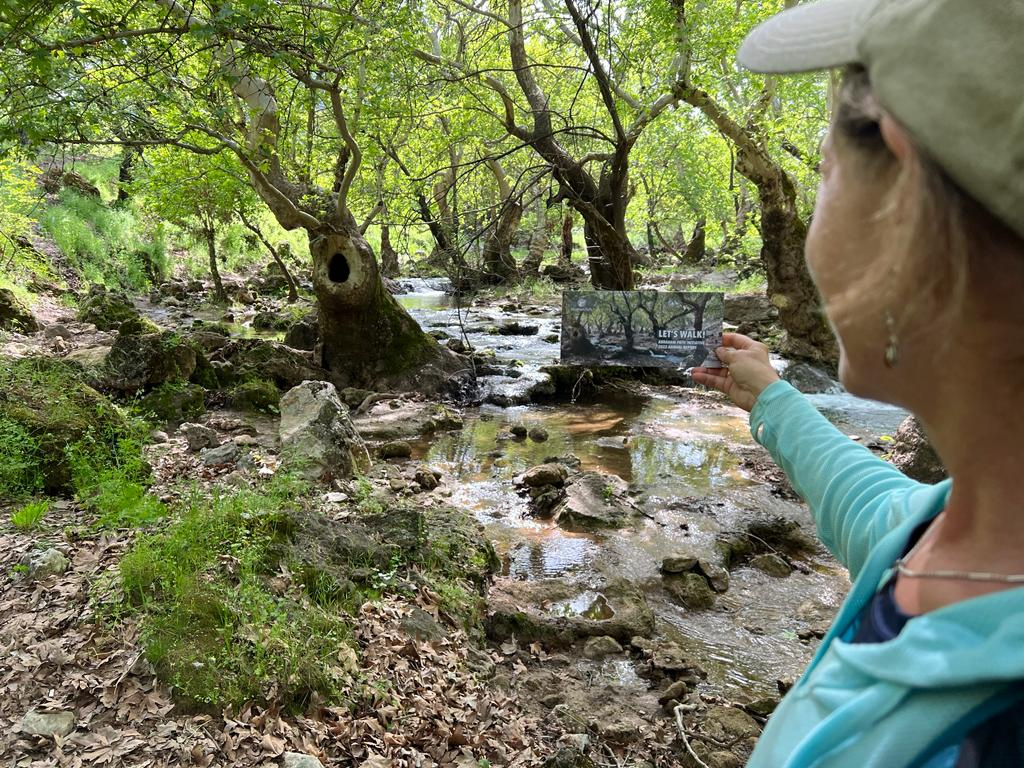
Lawin Mohammad (left) and Miran Dizayee (right) - co-founders of the ZMT - pose for a selfie with Anisa Mehdi (center) at Rwanduz Gorge
After Nineveh I traveled to the Kurdistan Region of Iraq to meet our partners in Erbil where they have been working to develop the Zagros Mountain Trail (ZMT). The ZMT is a 215km long trail stretching from the village of Shush in the west, to the foot of Mount Halgurd in the east. Walkers will pass through 36 different communities while walking the ZMT, retracing the steps of shepherds, pilgrims, and traders.
Over the last few years, API and our partners in Kurdistan have scouted hundreds of kilometers of trail, connected with homestay hosts and local guides, completed a technical through-hike, and launched day-long walks along portions of the trail. I was thrilled to finally have the opportunity to see the trail in-person, and walk portions of it!
We started at the Ezekiel Synagogue in Shush (circa 1330 CE). In 2020, the US consulate in Erbil allocated $500,000 for its renovation. Inside, our Kurdish partner and guide, Lawin Mohammad (center), gives a tour in Kurmanji, his native tongue, for the first time. That’s because two of our Ezidi colleagues from Shingal joined the walk. They speak the same Kurdish dialect. With us, in pink, is Sister Makrina Finlay, the Benedictine nun and lead researcher on API’s ALIPH-funded Ezidi intangible cultural heritage project. I like bringing people together.
The Kurdish landscape is widely varied. Look at the size of that cave! And it’s not even the biggest. Most famous is the Shanidar Cave, a bit further east, where The Smithsonian found signs of human funerary practices, dating back 30,000 years.
Fahad Shammo is filming Abraham Path’s research into the Ezidi tradition of xêr, mentioned in my post about Shingal. He loved the Kurdistan countryside. Portions reminded him of his beloved Shingal Mountain in Nineveh. Fahad’s elder brother, Ahmad, is our Ezidi project manager.
The next stop was Akre, a center of arts and intellect at the height of the Silk Road. We stayed overnight here with Tarek Akrawi, Iraq’s former ambassador to Austria, who has opened his home to ZMT walkers.
On to the Barzan Valley, where the Kurdish reigning political family laid down the law that no trees were to be uprooted, or animals hunted. We came across a unique system of trenches and taps, which turned out to be a shared irrigation system. Lawin explained these simple locks are spaced along the trench that comes from the mountain. They are opened and closed manually, daily, directing water to each of many family farms in turn. Sharing resources has been a cultural norm here for hundreds of years.
From the Barzan Valley we walked to the Rwanduz Gorge, stopping for a team selfie. There’s also a statue here of Archibald Hamilton, who built the Rwanduz Bridge in 1930, and engineered the famous “Hamilton Road'' through Kurdistan.
En route Dergala Village, for our final night’s stay in the Zagros with the family of former
Peshmerga general and current trail guide, Ahmed Rezani. Ahmed was featured in API’s 2022 Annual Report, and as you can see from the grin, he’s quite pleased! He was a fabulous host, inviting us to a feast of homemade dolma, a Kurdish specialty, and welcomed a domino's tournament with his son and Miran at the end of the day.
Back in Erbil, Lawin meets Baraa Jabbo, project manager for API’s intangible cultural heritage project in Baghdeda, Nineveh. I started my Iraq adventure in Bakhdeda, exploring textile practices of the Syriac community. The Ezidi team had already met Baraa. This circle of colleagues is complete.



